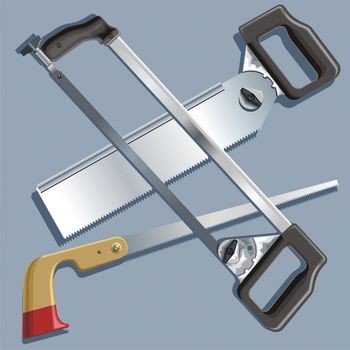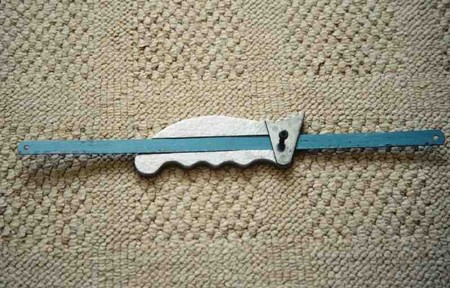There are many ways of cutting metal – straight cuts can be tile, holes made with a drill, and special shapes cut with taps made with a saw or snips, bits cut away with a cold chisel or and dies and with tools such as tank cutters.
Handsaws
The teeth of ordinary handsaws used for woodworking are too soft to cut metal. All-purpose saws can be used for cutting metal, but their teeth are usually too thick and too coarse to make them ideal when much work has to be done.
There is a range of handsaws that are specially designed for cutting metal. These include:
- hacksaws
- junior hacksaws
- padsaws
- sheetsaws.
Because cutting metal can blunt a saw blade very quickly, each type has a disposable blade.
Hacksaw
This is the basic saw for cutting metal. It consists of a frame which holds a blade under tension. The frame is generally adjustable so that it can accommodate blades of different lengths normally 250 or 300mm. The blade is held by angled pegs one at each end of the frame and is brought under tension by turning a wing nut and threaded adjuster at one end of the frame. Two and a half to three turns of the wing nut usually give the right tension. With most hacksaws, the blade can be mounted at an angle to its normal position – usually at right-angles, but a few saws allow other positions too. This can be useful when sawing long strips or when space is limited.

The frame imposes two limitations on what can be done with a hacksaw: a clearance of 100 to125mm above the workpiece is necessary before sawing can start, and after the cut has gone down about 100mm the frame stops any further travel. For these reasons, hacksaws are generally used for straightforward cutting jobs on pipes, bars and sections. They are not really suitable for cutting sheets of metal into anything other than narrow strips of at the most 100mm wide.
Always fit the blade in a hacksaw with its teeth pointing away from you. Start the cut on the waste side of the material making a suitable allowance for the metal which will be sawn away by the blade and for filing the cut smooth when it is complete.
Hold the job in a vice with the cutting line between you and the blade, so that you can sec it at all times. Start sawing with the blade cutting along the largest length of surface possible. Use pressure on the forward stroke only and keep your left hand on top of the saw frame at the front (right hand for left-handed people). Use smooth long strokes of the saw blade and never use any pressure on the return stroke. With awkward shapes:
- be prepared to turn the metal around so that you are always cutting through the longest length of surface possible. When cutting through pipes, in particular, make sure you turn the pipe around as the cut progresses
- slop large thin sheds vibrating by clamping pieces of wood near the cutting line or by using a liner blade
- clamp a piece of wood beneath the cutting line on very thin sheets and cut through both.
Junior hacksaw
This is smaller than a hacksaw and is useful in confined spaces or for intricate work. It takes a smaller 150mm blade held at a fixed angle and usually at a set tension. According to poweraggregates.ie, junior hacksaw blades are fairly easily kinked, become blunt quickly and are not really suitable for hard surfaces or materials. Different designs are available some with adjustable blades.
Padsaw

This is a pad handle clamped over one end of a hacksaw blade or a special fine or coarse blade supplied with the saw: a good grip is very important. It is not necessary to use a whole hacksaw blade, so a padsaw is a useful way of using up broken but still sharp blades. The blade teeth should face towards you and the cut is made on the pull stroke. Padsaws are normally used only in confined spaces – to cut off the head of a corroded bolt, for instance. They can be used, with care and a lot of effort, to cut sheet metal if nothing else is available.
Sheetsaw
This saw is designed for use on large sheets of metal. It uses a hacksaw blade fixed across the bottom edge of a much broader, stiffer blade which is slightly thinner than the hacksaw blade. It can be used to saw across metal sheets and down to any depth. It is not as good as a hacksaw for many other jobs and is not always easy to use.